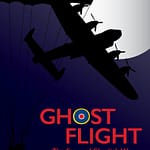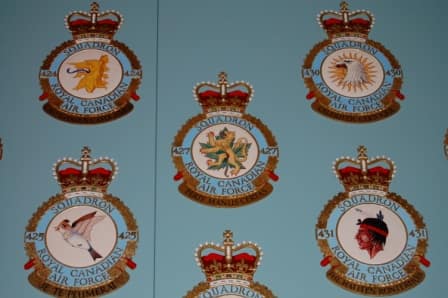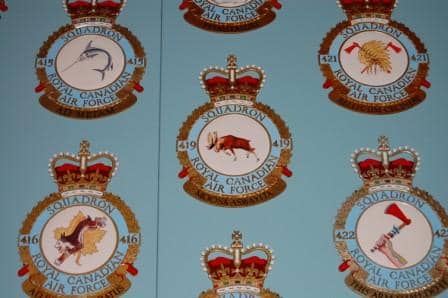
2008 Visit to the Canadian Aviation Museum, Ottawa
My son Paul brought me to the museum in Ottawa. They have a complete list of all the RCAF squadrons. I was quite impressed! They have this big wall that shows all the different squadrons. Each one like the Lion Squadron shows a lion, then a moose and a ghost. The French Canadian squadron was the Alouette Squadron. I met the Alouette Commander later on, after the war, when I was with a company; I guess I was in Toronto. The Commander was working for a big tire company.

In the museum they had an old Lancaster bomber, it was all roped off. Paul told the Director of the museum that I had done a tour of operations at the tail end of the bomber. The Director said he would give me a tour of the museum and I could go into the bomber. It’s a big, beautiful museum, up to date, starting with the bush flyers.

I climbed up the ladder to the Lancaster – they had a photographer there and they were recording everything; asking me about my time in the war. I climbed up and just sorted myself into the aircraft and moved down to the back – they said it’s quite obvious I’d been there before. Ya sure, sixty years ago! I went back to the tail, to the gunner’s position, I had to swing in, and you have to grab two little bars and get your body straight in and then reach up and lock the door.






Charlie and the rear gunners turret. It’s not surprising that he was one of a very few tall men to be rear gunners. The turret isn’t that big.
The Lancaster was a four-engine, but when my brother did his operations in 1940-41, they were flying Wellingtons. I believe the Wellingtons were two engine planes. We used them for training. In the Lancaster, I had to stoop down to maneuver through the plane. We entered at the middle, then going towards the tail in the back the plane narrowed. To get into the Boulton Paul tail turret there were a couple of bars I’d grab; then I’d have to swing into the turret. To lock the door I had to reach back with my right arm. I’d slide the door over and push it up into a little lock. So I was locked in really because the turret was turning at ninety degrees; I controlled it with two handles. The triggers were there for my Browning machine guns. The guns could be moved up and down. There were just five bolts that attached the guns – if they ever came loose it would be a disaster!
The odd thing about being in the aircraft was that I had confidence that the plane was well built and that I was secure in the back. I felt secure; there was nothing to worry about. I would’ve been more afraid to go to the top of a skyscraper and look over the edge.
The mid-upper gunner was up, in the middle of the aircraft. Luckily, they had a shut-off to stop the gun from extending enough to damage their own plane, and the guns couldn’t go back towards the aircraft.
I’d swing my turret over to the side and look out; I was the eyes of the aircraft – for spotting fighters or anti-aircraft fire, ack-ack, and flak that was coming from the ground. I remember counting enemy aircraft. Like, one off to starboard – you know – such and such a location. The navigator would be marking it down, or the wireless man – he took notes in his office because he was inside the plane – the poor buggers they couldn’t see what’s going on outside, that’s terrible, eh?
The navigator, in the middle of the plane, had all his instruments – there were no windows he could look out of – he was in the fuselage. The operator was probably beside him. The only other one that got a good visual was the pilot; he saw straight out, but he was steered into a bombing run by the bombardier. The bombardier was out in the nose, looking down, right down at the target; lining it up. He would say the direction of the bomb, then he’d say, “bombs gone”! He’d push the button, the bays are already open beforehand, when we went into the run, then he’d open the bomb door and bombs gone!


It did happen once that a bomb didn’t release from a plane. My cousin Jack was in an aircraft that landed and one of the bombs hadn’t dropped. As they landed, it shook loose and blew up the plane. My cousin and the pilot survived, but in the middle of the plane, it killed three or four people.

There were some Lancasters built here in Canada. I’m not sure if the Lancasters I flew in were built here or in Great Britain. We also had Mosquito bombers; they were the fastest at that time. They would go into Berlin – we’d call it a milk run, because it was daily, early in the morning. They went in regularly and bombed cities but the Mosquitoes were too fast and they had a hard time shooting them down. The German planes couldn’t catch them. They did damage deep in Germany and they’d return. We probably lost some, but they were very successful – they were frightening to the German people.


The Mosquitoes were amazing! In the Lancaster we were more lumbering. We were superior to the Americans. They talk a lot about the B17’s, but we had a superior plane! Lumbering as it was, the Lancaster was still more manoeuvrable. The Americans – a whole cluster – went over in daylight raids, when there was no fog. We always said they’d get lost in the dark. We could go in the pitch-black night in our bombers. We very seldom fought fighters – if we saw a fighter we’d do evasive action so as not to give away our position in the night sky.
I remember the adrenaline flow was tremendous when we were dropping bombs over a city. In the heavy zones, like the industrial area of the Ruhr Valley, it was just a complete wall of enemy fire. We could hear it beforehand, and when we got closer it would shake the aircraft. That’s where there’s adrenaline. It was more exciting than frightful, ya know? I think we were too young and stupid, most of us; it was always something would happen to other people, but not to us.
During the war, I was about 180 pounds, at that time I was a little bit bigger because I had been playing junior hockey; defence. I was a little taller then too. Of course, we shrink in old age, but then I was slightly over six feet.
There were only two or three of us on the squadron who were that big, they could just squeeze into the darn turret. The ideal size for a gunner was five foot four, like a jockey, and then they could move around. In fact, I was so tight in there – I remember on a bombing raid to Stetton, that my electric suit, which I wore underneath a jacket – anyway, in the electric suit the damn wire at my backside was broken. I started getting sharp shocks on my backside! It was about -20C over Stetton and we’re out in the open air, eh? The electric suit was the only heating I had. It was freezing! My face was frozen! I had a piece of chocolate in my pocket and I couldn’t break it, it was so hard. I tried tilting my body so the wire would pull away, but then the other side got a shock. This was about a nine and a half hour flight. We went over Sweden, Denmark and the other Scandinavian countries. We went up that way to avoid fighters or something, it was a safer route – they always checked at the base. Before operations all the crews and pilots would be in a briefing room together, to get ready for that night’s bombing. A senior officer would have a map and tell the pilots and navigators the route, and which buildings were targets. It wasn’t our concern but they told them what cities to go to, what heights to fly; to miss the radar, like when we went to Bergen, Norway to stay below the radar. Usually, there were about ten crews going out. Intelligence knew what our chances were coming back, and if we could avoid radar, then all the better. We were on our way to a major target, I can’t remember which one. It was the longest and most uncomfortable trip!
Other trips I didn’t mind – we had five or six-hour trips into the Ruhr Valley. They were really hot when you got there; the firepower the Germans had was unbelievable!
A fellow sent me a sheet on the percentage of gunners returning. That is – very few gunners returned! So I was blessed, I was very lucky! I remember counting every time I went out, I’d count five or six bombers blown up around me.
We always flew in a group and it was always night bombing. We had tremendously intelligent navigators, they were awfully good! They were superior to any other navigators in other air corps that flew bombing missions. That’s why we flew at night because of our navigators and our pilots. We were mostly all Canadian but there were a couple of Aussies and a couple of Americans, that’s all I can remember. We started earlier in the war than the Americans, they only joined later.
I remember one American fellow, he was a gunner from Los Angeles and claimed to know Victor Mature. Anyway, we used to carry one civilian suit; we were allowed to wear it occasionally. So I had a suit; it fit me fine. This fellow from L.A. – when I got shot down – he took my suit! He had a tailor fit it to him. I came back and I asked him what he did to my suit, it didn’t fit me anymore. He was slightly slimmer than I was and it was tailored for him. This same fellow, I don’t know why he joined the force as a gunner. He made a couple of trips and anytime after that when he had to fly, he had a tooth pulled out. He must’ve run out of teeth! He was very disturbed about going, flying as a gunner. In other words, he changed his mind and didn’t want to go anymore! He must be wearing a nice plate now because by the end of the war I doubt he had any teeth left, though he’s not the only one who did that.
I had been commissioned as a Pilot Officer early in my bombing excursions. I flew with a Wing Commander a couple of times. I flew with all different ranks. A number of operations I flew with a chap who was a Warrant Officer. He came from the Maritimes and was a tremendous flyer, but rather undisciplined. He didn’t wait for instructions from the base office, but he was the best pilot I ever flew with. Sometimes coming back from a flight, maybe a training flight, he’d go right down close to the farm fields and the cows would hear the roar from this big bomber. That was funny! When the weather closed in we were diverted and we’d land at an American base. In fact, we met Clark Gable one time; he was based on a nearby American squadron. I carried a few dollars or pounds if I wanted to indulge in liquid refreshment on an American base. This pilot wouldn’t wait for instructions to take off. As soon as the fog turned, he’d say, “let’s go boys!” The control would be telling him to hold but he’d tell them – no, it’s okay, let’s take off! So this was why he was only a Warrant Officer pilot and here I was a Pilot Officer, about a couple of ranks higher, but I was out in the tail end.


We didn’t have jets during the war. The first jet I told you about when I was in the camp at Nuremberg, this thing was flying like – vroom! I thought – what the heck! You know? I guess it was one of the first ones, the first for the Germans; they worked on that all through the war with slave labour.
The Germans had those V1’s and V2’s. I was in London when the V1 and then V2’s later on, came in. When the engine shut off over London, it would come down and blow up a whole block of houses. They were very destructive! The technology was fantastic though! Thank goodness the bombers knocked off a lot of them. The V1’s flew where you could see them coming in – maybe a thousand feet up. When we were on the street, they chased us off; they’d make us go down into the underground.
The V1 would go up and it would stay at one level so you’d hear it coming; from the ground, you’d see a flying bomb. The motor was going, making noise, so once it got above you, you knew it was going to be hitting something further on. That was the V1. Then they went to the V2. The V2 would take off from the coast, France or whatever, and they would go straight up, thousands of feet up, so you didn’t see anything till it was too late. Then it would fall straight down and blow up everything.
If I recall, the V1 was on contact, as soon as it hit a building it would blow up. It would hit, shoot out and scatter on buildings all around. The V2, the one that went so high and came down, it went deep into a building and then blew up everything above it. It blew from a deep hole.
When we had to take shelter in the subway in London – we had chocolate bars from the PX or Red Cross and we’d give them to kids in the bomb shelter.
Everything around St. Paul’s Cathedral in London was all wiped out, but they never hit the cathedral.
V2 seen from the air: “Another “first” was claimed on the 10th when F/Ls R.M. Currie and A.H. Rose claimed a visual of a V.2, an object which they at first mistook for a doodle-bug or flying bomb until they observed its spectacular rate of climb. Many crews subsequently reported seeing the reddish orange light of this new weapon. All remarked that while the light appeared at first to be stationary it accelerated rapidly as it rose beyond the level of the observing aircraft. It remained visible for a period of 1 1/2 to 2 minutes and was invariably headed in a westerly direction.” Excerpt from the RCAF Overseas Vol 3, pages 349-350
I remember when we’d go to London on leave, we’d go to the Beaver Club, which was the Canadian’s club. We’d meet at the Beaver Club. You might meet fellows in the Army, Navy, and the Air Force that were friends for years back home. You could leave messages if you wanted to meet somebody from your gang.
The Beaver Club was in Canada House in London. The CBC had radio broadcasts there for any Canadian Forces men or women who wanted to say hi to family and friends at home. The CBC has the archives of these WWII broadcasts on their website.




